L.E. Carmichael's Blog, page 12
May 13, 2022
Sylvia McNicoll: What the Author, Now, Knows
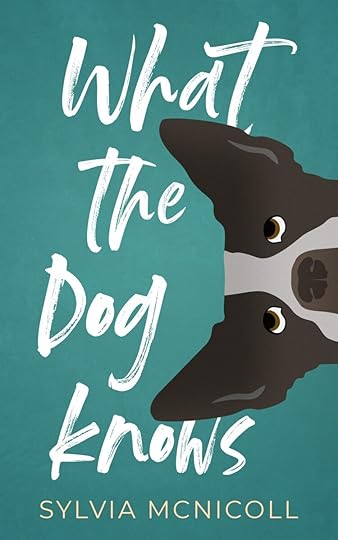 Welcome to Cantastic Authorpalooza, featuring posts by and about great Canadian children’s book creators! Today’s guest:
Sylvia McNicoll
. Take it away, Sylvia!
Welcome to Cantastic Authorpalooza, featuring posts by and about great Canadian children’s book creators! Today’s guest:
Sylvia McNicoll
. Take it away, Sylvia!
For all the dogs I’ve known in my life, I wrote What the Dog Knows. Such a slow and pleasureful project; it took nearly ten years of revising the story and evolving the characters. No one rushed me, I fulfilled other deadlines in between. But I always returned to revisit 14-year-old Naomi and her canine savant, Diesel. Now as I hold my 40th novel, I look at the aqua cover with the perky dog peeking sideways from the edge, and I am happy. For the first time in my career, I did not rush the writing and perhaps as a result I can start reading the story and still love and be lost in it.
Why do I enjoy writing about dogs so much? When I was a little girl, I remember wandering the sidewalk with a pack of dogs. Those were the days when children and animals were given free reign. Post World War by about 10 years, older kids bullied me over my German parents, Nazi backstabbers they called them. But the dogs never made fun of me, they just liked being with me, accepting treats and pats with friendly licks and wagging tails.
For my seventh Christmas, my father finally bought me my own dog from the animal shelter. We named the small shivering terrier Dino after the Flintstones’ television pet. Like the father in What the Dog Knows, my dad needed to be a job chaser and probably chose my pet because of opportunity: the shelter was located across from where he worked at the time, and affordability: Dino cost five bucks. Also like Naomi’s father, he couldn’t afford vet bills. That skinny sick dog just had to grow better on her own. Dad couldn’t afford swimming lessons for me either and I nearly drowned when he attempted to teach me himself. You just throw a child in, right? They’re forced to swim. Only I sat stubbornly at the bottom, watching bubbles rising to the top. You can read that scene almost exactly the way it happened in What the Dog Knows.
My father was a taciturn man who couldn’t talk to me. In my teen years, he would communicate to me through our dog. “What do you think, Dino? Do you think Sylvia would like a piece of chocolate? Do you, girl?”
Wagging tail, panting tongue meant Yes, of course, Sylvia wants a piece of chocolate. Dogs aren’t complicated. Maybe they can’t talk to us inside our heads the way Diesel does with Naomi but they really try to tell us things with their bodies. We just have to pay attention. Then if we pay attention to their body language, maybe we can take that skill and look at each other and try to understand what our human friends really want as well.
Many dogs later, walks with our canines provided me time to bond and communicate with my own children. I felt it was easier for them to grow empathy with a predictable furry friend than a human one. It was also easier to weep unabashedly when our dogs died. It was as though all our other losses could be fully experienced in their passing.
Spoiler alert, NO DOGS DIE IN WHAT THE DOG KNOWS.
I took some of the grief, disappointment, and unhappiness that teens experience and over the years of writing, gave them to Naomi, a lonely girl who is finally taught by her dog to believe and see the best in a human friend. I took all the dogs I knew and combined their energy and fun into Diesel, a dog who communicates some universal truths. A dog who feels you have to keep your family together because “a bigger pack can bring down a moose.”
What I learned from the project: to live in the story moment and not to rush it. Writing is a pleasure you can savour. I’m hoping my readers will find joy in savouring the reading of What the Dog Knows too.
Enjoy the trailer for What the Dog Knows here: https://youtu.be/2mqRt80S7Yg
Sylvia McNicoll is the author of Silver Birch-Winning Bringing Up Beauty and more recently The Great Mistake Mysteries and Body Swap. She lives in Burlington, Ontario with her husband and continues to be inspired by her own dog Mortie and her nine grandchildren who all live close by.
May 6, 2022
Charis Cotter – Scary Dolls and Haunted Dollhouses
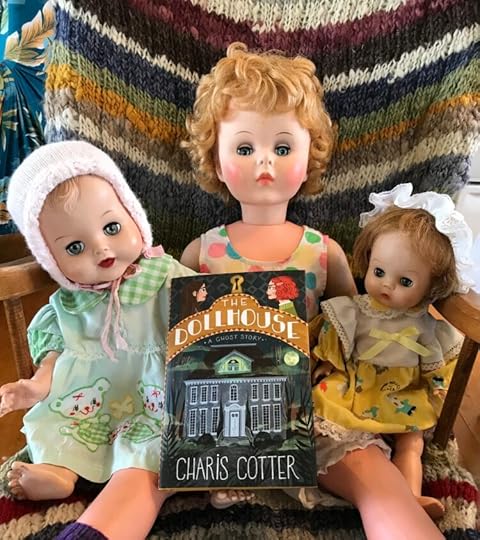 Welcome to Cantastic Authorpalooza, featuring posts by and about great Canadian children’s book creators! Today’s guest:
Charis Cotter
. Take it away, Charis!
Welcome to Cantastic Authorpalooza, featuring posts by and about great Canadian children’s book creators! Today’s guest:
Charis Cotter
. Take it away, Charis!
I was devoted to my dolls from an early age, and my love of dolls has never left me. I think I have about 26 or 27 now … I’ve lost count. Most of them are tucked away in a storage box because I live in a small house, and my visitors don’t seem to appreciate dolls the way I do. Many people find my dolls scary, but to me they are just rather quiet, undemanding friends.
When I was seven, a girl down the street, whom I didn’t really like that much, had a great Barbie-doll collection with a Barbie carry-case full of Barbie clothes. I wasn’t allowed to have a Barbie because my mother thought her breasts were too big. So I would toddle down to—let’s call her Wendy—Wendy’s place to play with her Barbies. One day I gave into fierce temptation and stole her Barbie carry-case. Of course Wendy’s mother arrived at the door a few hours later to retrieve it. I got a spanking and it just made me dislike Wendy more.
When I was in my thirties, I spent some time living in the house where I had grown up, and Wendy still lived down the street. Eventually she sold the house and didn’t bother clearing it out. The new owners hauled out all the stuff she left behind and put it in the back lane for garbage pick-up. I was walking by and saw a three-foot walking doll among a pile of cardboard boxes. I investigated, and found two more dolls, all circa 1950s. That’s how Jane, Ruby and Lucy came into my life. After thirty years, I finally got Wendy’s dolls.
Loving dolls means of course I also love dollhouses. And I have a passion for historic houses. A few years ago, synchronicity struck. I became friends with a woman who lived in a wonderful restored Georgian house with a dollhouse in her bedroom. My latest book, The Dollhouse: A Ghost Story, was inspired by that friendship.
I first visited the house when my father introduced me to Ruth, an old acquaintance who, at the age of 91, had just bought a historic house. I had recently lost my mother, and Ruth had been in residence at university with her in the 1940s, so we had an instant connection. The house was grand and mysterious, with lovely furnishings and a kind of hushed feeling, as if it held its elegant history within its walls and was quietly waiting for more gracious parties and ladies in long skirts swishing up and down the stairs.
I visited Ruth many times, and we played with her dollhouse.. She had boxes and boxes of miniature furniture and china and dolls. Eventually I was allowed to venture into the attic, but only with a friend, because the stairs were very steep. When I saw the huge, shadowy space with wide pine boards that were cut from old-growth forest in the 1830s, when the house was built—my story settled inside me like a billowing sheet coming to rest on a bed.
A haunted house. An old lady in a bed upstairs. A secret dollhouse hidden in the attic. And a curious girl who has a concussion and can’t quite figure out what is real and what is a dream. On the very first night she wakes up to find a ghost girl in her bed.
One of the magical things about writing The Dollhouse was that every time I went to visit Ruth in her marvellous house, I felt my fictional house superimposed on it, and my characters began to whisper in the rooms around me, and run up and down the stairs. I’ve never been so specifically inspired before. Blackwood House is almost an exact replica of Ruth’s house, in much the same way that the dollhouse in the story is an exact replica of Blackwood House. Houses within houses, dreams within dreams.
Now when I visit Ruth, I sometimes take a spin around the house, and my book and characters come to ghostly life around me. At home, Jane, Ruby and Lucy sit in my study as I write my next book, and my other dolls sleep and dream in their box in the storage room, waiting for their chance to come out and fill my imagination with their stories.
Charis Cotter is the award-winning author of twelve books, including The Swallow: A Ghost Story and Screech! Ghost Stories from Old Newfoundland. She is one of the authors touring Canada in Canadian Children’s Book Week 2022 from May 2 to 7, when she will visit schools in British Columbia, Manitoba and New Brunswick.
Want more? Check out this video of Charis reading a ghost story from her book Screech! Ghost Stories from Old Newfoundland (appropriate for grades 3 and up):
May 2, 2022
Science Rendezvous Is Almost Here!
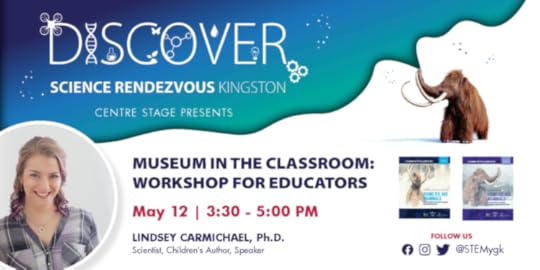 If the last two years have taught us anything, it’s that science matters. It helps us solve problems, find solutions (or mix them!), and make life better.
If the last two years have taught us anything, it’s that science matters. It helps us solve problems, find solutions (or mix them!), and make life better.
From dinosaurs to robots to hoverboards to vaccines to things that go boom, science is also really cool.
Canadian science lovers get to celebrate twice a year: in September, during Science Literacy Week, and in May, during Science Rendezvous. And Science Rendezvous 2022 is almost upon us!
If you’re not familiar, Science Rendezvous aims to bring regular people into contact with scientists of all stripes. It’s a chance to learn about science and what scientists do, and a chance for people of all ages to participate in science. And unlike museums and science centres, which usually charge entrance fees, every experience at Science Rendezvous is totally free!
This year, I’ll be talking about Ice Age mammals at Science Rendezvous Kingston. My student workshops are fully booked, but there’s still space in my virtual teacher workshop on May 12. I’ll be introducing an incredible new palaeontology teaching kit that educators across Canada can bring into their classrooms for free. If you are a teacher or know one, spread the news! I’d love to see you.
If you’re near Kingston, be sure to check out all the other amazing activities on the schedule. And if you’re not, no worries! Science Rendezvous is a national event – check the main webpage to find events happening near you.
Get out and get sciencey, everyone!
April 8, 2022
Carol Matas – Who’s Looking? How Animals See the World
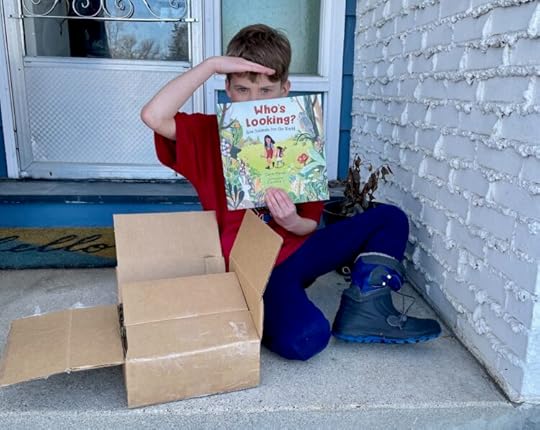 Welcome to Cantastic Authorpalooza, featuring posts by and about great Canadian children’s book creators! Today’s guest:
Carol Matas
. Take it away, Carol!
Welcome to Cantastic Authorpalooza, featuring posts by and about great Canadian children’s book creators! Today’s guest:
Carol Matas
. Take it away, Carol!
Who’s Looking? How Animals see the World, is my new, (very first) picture book, illustrated by Cornelia Li.
A conversation with my grandson was the catalyst that sent me off into the wonderful, surprising world of how animals see. One summer day we were strolling home from the park. I was pointing things out to him: flowers, leaves, trees, birds, insects. We stopped to cross the street and noticed some ants. I asked him how he thought we would look to them. (He was around seven years old.) We agreed we would certainly look like giants to the ants, if they could really see all of us at all. Which made me wonder – what did they see? And that made me want to write a book about how animals see.
That day I went home and began my research. What I found was astonishing. It was difficult to choose which animals to include in the manuscript since they all have such unique ways of seeing.
Who knew whales could only see shades of grey and black? Who knew rabbits could see so well behind them? Who knew robins can sense the earth’s magnetic field, through their eyes? Or that dragonflies have almost 360 degree vision? And the little ant? It can barely see at all! Well, no doubt a lot of scientists know all of this, but I didn’t, and I hoped I could convey at least part of my excitement and wonder in the manuscript.
The first draft of this book was about a fictional character discovering all of these wonders. The first editor I submitted to said she was only looking for nonfiction. So I thought – well, why not try to turn this into nonfiction? She didn’t buy it in the end, but Orca did and I am very happy about that!
One of the most difficult tasks for me as a writer was to simplify and condense the extremely complicated mechanisms each animal uses in order to see. For instance, cryptochromes and quantum coherence became: robins can sense the earth’s magnetic field through their eyes. For each animal I had to take a very complex mechanism – like what makes up a compound eye – and make it understandable to a 4-year-old. The number of revisions my editor and I went through were massive, (and seemed never ending) until we felt it was both scientifically correct and fun to read and understand.
And the book did end up with a kind of story. Initially I saw it as a book that would illustrate just the animals’ point of view. But as I worked with Orca, and with help from my agent, it evolved into a story of two siblings who explore the world around them, even as the world around them is looking, too. Orca had suggested a bubble on each page and inside the bubble the reader would see what the animal was seeing. However, Cornelia developed the idea of having a cone through which we could see what the animals see. Cornelia developed a perfect combination of my vision and Orca’s.
The book ends with these lines:
What does the world look like? It depends on who’s looking.
And the wonderful thing is, it takes more than one set of eyes to get a full picture.
And in these difficult times, I hope Who’s Looking? will encourage children to realize that we all see slightly differently, but that diversity is our strength.
March 4, 2022
Catherine Egan – No Writing Is Wasted
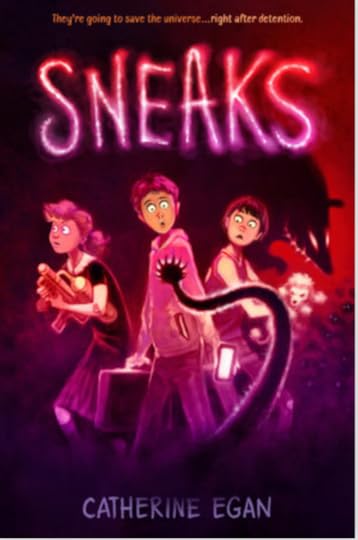 Welcome to Cantastic Authorpalooza, featuring posts by and about great Canadian children’s book creators! Today’s guest:
Catherine Egan
. Take it away, Catherine!
Welcome to Cantastic Authorpalooza, featuring posts by and about great Canadian children’s book creators! Today’s guest:
Catherine Egan
. Take it away, Catherine!
Years ago, when my first child was an infant, I swore to myself that I could and would keep writing. I was still working part-time in a restaurant and doing bits of freelance work, but I was determined to Do It All. The book I wrote during that first exhausting year of motherhood was a disaster. Two hundred pages in, I knew it wasn’t working. As a writer, it’s hard to know when to jump ship. Are you cutting your losses and moving on, or just quitting when it gets tough? I had worked so hard on that book, and there was so much I loved about it. I kept banging away at it for a while, laptop balanced on a cleared space on the bookshelf and baby napping in a sling because he napped longer on my body. I swayed, rocking the baby, and typed, not rocking the book. I just couldn’t make it come together. I left the wreck of that book behind me, but I felt like a failure.
A year or two later, I went diving back into that wreck and ransacked it for parts. Much of my intricate world-building and a number of characters ended up as salvage – I put them to far better use in the story that became my YA fantasy Julia Vanishes.
When my second child was an infant, I wrote another terrible book. (Do you see a pattern?). I finished that one, but I never sent it anywhere. I knew it was a broken book and no amount of editorial wizardry was going to fix it. I’d learned a little bit, by that point, about what was fixable and what wasn’t. My favorite thing about that failed book was an enchanted, maze-like house with a hundred rooms that functioned kind of as a puzzle. Years later, when I was in the early stages of outlining Sneaks (my recently published middle-grade novel), that house became salvage, and I put it to work in my new draft.
Sneaks is a sci fi puzzle book about friendship, middle school and aliens trying to take over the universe, but it’s also a book about failing and trying again. My protagonist, Ben, tries to be a good friend and a good brother – fails – and tries again. He tries to do the right thing, to save the universe, but he fails – and tries again. At my most optimistic, I think I can use all my failures – in books, in life – and turn them into new books, fresh starts, second (or third, or fourth) attempts at getting something right.
No writing is wasted. There is always the chance of salvage and, of course, there are the things you learn from failure. I used to find Failure a cruel teacher, but I don’t feel that way anymore. Maybe I’ve just gotten used to it, and the older I get, the easier it is to take the long view. I begin each book with more confidence. I’m starting to see the pitfalls before I dig them and then fall into them. I pile up lessons – and material! – and carry them with me forward.
Now I’m at the very beginning stages with a new book, that blissful stage before you’ve made any mistakes, written yourself into any corners, or just found yourself banging up against your own limitations. But I’ve gotten so much better at all this – at writing, at fixing, at quitting, at salvage, whatever the book requires. For now, the book exists only in my imagination – where it is absolutely perfect.
If you are interested in seeing any of my blunders in real time, links to my online self below!
Website: www.catherineegan.com
Facebook: https://www.facebook.com/byCatherineEgan
Twitter: https://twitter.com/ByCatherineEgan
Instagram: https://www.instagram.com/bycatherineegan/
February 25, 2022
When Was the Last Time You Played?
If you’ve got young kids, probably pretty recently. If you don’t?
Was it pre-COVID? Longer?
For me, definitely longer. I am a responsible, disciplined, goal-oriented adult. It has been so long since I played that when people ask me what I do for fun, I actually have to stop and think about it.
“Fun? What is this “fun” of which you speak?”
This year, I am on a quest to down-regulate the stress and up-regulate the fun, in hopes of approaching that thing people call “balance.” Honestly, I’d settle for tamping down my anxiety to a murmur instead of a roar.
Either way. For me, one key skill is going to be remembering how to play. Here’s where I started:
https://www.lecarmichael.ca/wp-content/uploads/2022/02/Somersault.mp4
I haven’t done a somersault since I was probably 8 years old. Doing something silly and childlike and unambiguously playful in my body felt AMAZING* and I recommend it, with or without supportive friends watching on Zoom!
What about you? How do you play? I am taking suggestions. Bonus points for physical activities which also down-regulate the stress hormones!
*Also a little rough on my neck – next time I’ll tuck my head under a bit more before I start. Pro tip. 
February 9, 2022
Isabelle Groc: Lessons from Conservation Canines
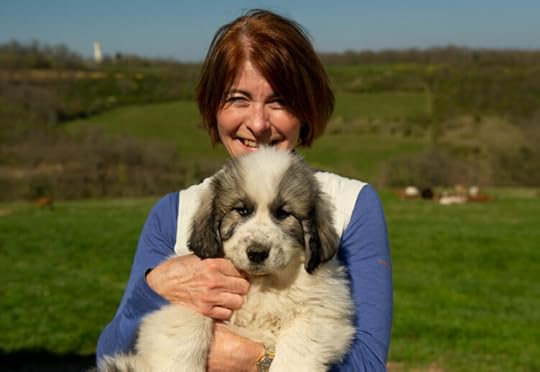 Welcome to Cantastic Authorpalooza, featuring posts by and about great Canadian children’s book creators! Today’s guest:
Isabelle Groc
. Take it away, Isabelle!
Welcome to Cantastic Authorpalooza, featuring posts by and about great Canadian children’s book creators! Today’s guest:
Isabelle Groc
. Take it away, Isabelle!
I have shared my life with cats for the last 30 years, and I could not imagine not having a feline companion at home. I adopted my first rescue cat in Harlem, when I was a student at Columbia University’s Journalism School, and since then cats have supported me on many of my writing journeys. They are an integral part of my daily de-stress routine.
My passion for cats began as an adult. When I was a child, I grew up with an Irish setter named Pipo, in a small town in the southwest of France. My father loved this breed, which reminded him of the time he spent with his uncle and his hunting dog in the Pyrenees Mountains. This was my very first introduction to working dogs, and little did I know that decades later, I would cross the path of another working dog that would change my life.
I met Alli, a beautiful and energetic nine-year old Australian cattle dog in a wetland area near Vancouver (where I live now) while I was making a documentary on the efforts to conserve the endangered Oregon Spotted Frog. In Canada, just 400 to 700 frogs are left, distributed in six isolated populations in British Columbia. Trying to discover new frog populations in pockets of wetlands through traditional surveys is a time- consuming and unreliable process, particularly as it is difficult for people to move through these habitats. Surveyors walk slowly in knee-deep mud during the short frog-breeding season and can easily miss the frogs.
That day, Alli had been called in to help wildlife biologists to detect the elusive frog. Dogs are nimble and fast, cover large areas in a short period of time, and their powerful noses can catch the scent of a species very quickly. I was amazed by Alli’s confidence and agility, and how quickly she found one of the frogs. I discovered that all over the world, dogs are increasingly being used for wildlife conservation. In addition to tracking elusive or rare endangered animals and plants in rugged terrain, they find invasive species, and they fight wildlife trafficking by sniffing out illegally obtained animal products such as shark fins and elephant ivory. They can even help reduce human-wildlife conflicts. These conservation canines are truly scientists’ best friends, helping them collect vital information they would not have access to otherwise. For example, the scat samples they can detect from many different species can tell researchers everything from the animal’s diet and stress levels to their reproductive health and exposure to toxins and population abundance.
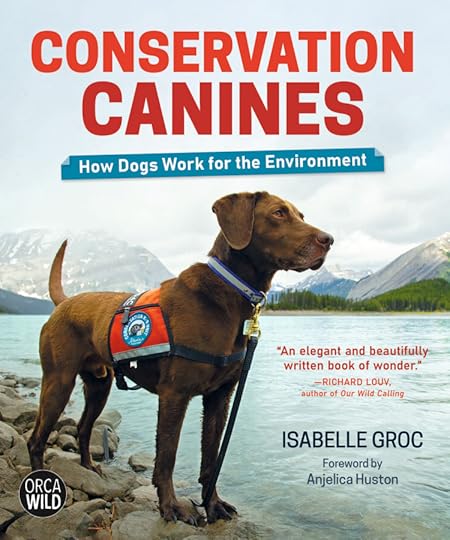 I fell in love with these conservation canines, and I spent several years travelling to meet these dogs and their human partners. The canines always showed a level of enthusiasm, energy and dedication in helping me tell their stories that I had rarely encountered before with any interview subjects! They were always patient, they happily let me photograph them, and they constantly encouraged me with wagging tails. I was very honoured to tell their stories in words and photos in my latest book Conservation Canines: How Dogs Work for the Environment published by Orca Books in September 2021.
I fell in love with these conservation canines, and I spent several years travelling to meet these dogs and their human partners. The canines always showed a level of enthusiasm, energy and dedication in helping me tell their stories that I had rarely encountered before with any interview subjects! They were always patient, they happily let me photograph them, and they constantly encouraged me with wagging tails. I was very honoured to tell their stories in words and photos in my latest book Conservation Canines: How Dogs Work for the Environment published by Orca Books in September 2021.
So will I eventually get a dog in my life? Probably in the future but in the meantime, I often think of Alli. She is now retired and will be celebrating her 18th birthday in April. I am also reflecting on the lessons that Alli and all conservation canines have taught me, with the hope that book readers will be as inspired as I am by these extraordinary dogs. I think about how we can look at dogs (and cats too!) in our lives differently, from their point of view. After all, dogs experience the world through their noses, and when we follow their lead, we can expand our own perceptions of the world around us, from a less human-centric perspective. If we pay attention, dogs can give us access to a new way of appreciating the details of the natural word.
Conservation canines also give us the important message that we can do our part to protect our planet’s biodiversity. Dogs make the world better and can inspire us to do so too!
To learn more about my work, please visit my website and follow me on social media:
Instagram: @isabellegroc https://www.instagram.com/isabellegroc/
Facebook: @isabelle.groc https://www.facebook.com/isabelle.groc
Twitter:@isabellegroc https://twitter.com/isabellegroc
January 28, 2022
Organizational Structures for Clear, Effective Writing
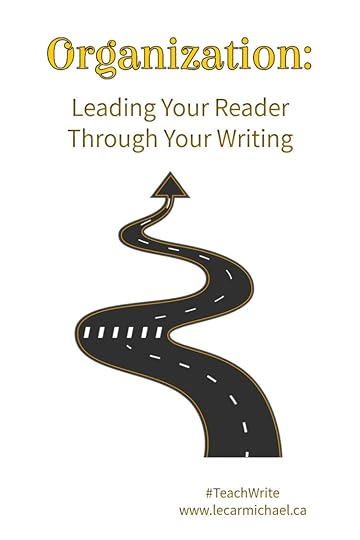 Welcome to Teach Write! This column draws on my 20 years’ experience teaching writing to kids, university students, and adult learners. It includes ideas and exercises that teachers and students can use in the classroom, and creative writers can use to level up their process.
Welcome to Teach Write! This column draws on my 20 years’ experience teaching writing to kids, university students, and adult learners. It includes ideas and exercises that teachers and students can use in the classroom, and creative writers can use to level up their process.
If your January is anything like mine, it’s all about getting organized (again). So today, we’re talking about organizational structures in writing. Figuring out the best structure for your material is one of the primary benefits of outlining. This column is for non-fiction writers, whether you’re working on an essay, a term paper, or a children’s book.*
But first things first. Why am I harping on organization? Because as I said last time: I’ve read hundreds of student papers over the years, not to mention the thousands and thousands of other things I’ve read, in pretty much every genre and format there is. Hands down, the biggest barrier to a reader’s comprehension is poor organization. That’s so important, I’m going to say it again:
The biggest barrier to comprehension is poor organization.
Writing isn’t just about figuring out what your reader needs to know. It’s about understanding when they need to know it: at what point during their reading experience is that idea, fact, or dramatic incident going to make the most sense or have the most impact? And, by extension, at what point in the reading experience is that idea, fact, or dramatic incident going to be so confusing the reader tosses your work down in disgust? You know it happens – you’ve probably done it yourself.
That’s all an outline is, really – a map for what you’re going to write and when.
So, what kinds of structures are available to us, and how do we choose?
We don’t. We let the material choose for us. Here’s how.
SubtopicsSometimes, your goal is to give an overview of a topic or field. This is common in term papers or in traditional, survey-style children’s nonfiction, and organizing material by subtopic makes a lot of sense. For example, if you’re going to discuss human uses of honey, you might want a section on honey as food, honey as medicine, and domestic honey as an industry. It makes sense to finish talking about each subtopic before moving on to the next.
If you’re a visually-oriented kind of person, picture “honey” in the middle of a mind-map with spokes moving out to each subtopic. That’s the kind of structure we’re talking about here: a bunch of ideas surrounding a central theme.
Order of ImportanceI consider this one a variation on the Subtopics structure, because all it’s really about is figuring out the order the subtopics should go in! There are two schools of thought on this. If you’re a journalist, you’re going to start with the most important and work your way down, on the assumption that newspaper readers want the good stuff first and might not make it all the way to the end of the article. On the other hand, if you’ve opened with a good hook, there’s something very satisfying about moving on with “less” interesting stuff and working your way up to the most compelling information or evidence you’ve got – the “end with a bang” approach to making an argument.
That being said, anything that’s genuinely not interesting probably shouldn’t go in your outline to begin with!
ChronologicalSometimes, a linear structure makes a lot more sense. If you’re writing history, biography, or about the life cycle of a bee, things happen in order, and your writing will make the most sense if it reflects that order.
Humans are good at visualizing time as a straight line, so this structure tends to be easiest to master. Level up by arranging the clauses in each sentence in chronological order, too!
Cause and EffectThis is another linear structure, and in most cases, it’s chronological, placing causes before effects in an unbroken chain. Not always, though! Part of our goal as writers is to capture an hold our reader’s attention, which means that, in some cases, it’s more effective to present the effect (result), and then go back to trace the chain of events that led to that most interesting situation. History and biography writers use this trick a lot.
Problem and SolutionThis structure is very similar to cause and effect, in the sense that a problem exists (cause) and we’re trying to solve it (effect). Pretty much every lab report or scientific paper ever written follows this structure, but it can also be used for research papers or books that deal with “issues” and the ways we might address them. In that case, a problem-solution might incorporate a compare and contrast structure, as you present alternatives and evaluate their relative strengths and weaknesses. Which leads me to…
Compare and ContrastIt’s usually pretty obvious when this structure should be invoked – if you’re a student, your teacher will tell you to use it! Unfortunately, it can be the trickiest to execute well. The easiest way to attack it is to present ALL the information for Option A, then go on to Option B… which runs the risk your reader will forget your arguments about Option A before you make a conclusion. Alternating between A and B in each paragraph is more sophisticated and can be really effective, but if you struggle with transitions, it’s going to feel choppy. Proceed with caution.
Infinite VarietyAre those your only options, you ask? Nope! I once wrote an article that was organized by size: from biggest to progressively smaller. The only rule here is that the structure makes sense for your material, so don’t be afraid to get creative.
And don’t be afraid to try more than one. Another advantage of outlining before you start to write is that you can experiment with multiple structures before you commit. That saves time, and here at Teach Write, we are all about efficiency.
Next time: methods of outlining that won’t make you want to murder someone!
Hey, did you know I teach writing workshops? It’s true – I work with adult writers, teachers, and students of all ages. Contact me to learn more.
*Structure is just as important in fiction, but the strategies are different. We may talk about those later. 
January 14, 2022
Welcome to 2022
Two weeks into 2020-too – how is everyone doing?
It’s been a mixed bag for me so far. In the YAAAAAAY column, I got my COVID booster (woo vaccines! woo science!) and The Boreal Forest won the 2021 Information Book Award!
Kermit GIF from Kermit GIFs
Thank you so much to the Children’s Literature Roundtables of Canada for this honour! Also, every book on the shortlist is awesome, so check them out.
In the BOOOOO column, I got the results of my sleep study. My heart, lungs, and legs are all fine, which is great news, BUT… I’m waking up 8 TIMES PER HOUR.
Which, no wonder I’m exhausted all the time. On the one hand, this is incredibly validating – it’s not all in my head. But it IS in my brain, and one of the things I’m supposed to do in order to sleep better is reduce my stress levels.
*looks around at the world*
*laughs hysterically*
Yeah. I’ll work on that.
Speaking of the pandemic, does anyone else get vaguely uneasy when movie or TV characters are in crowded places and NO ONE IS WEARING A MASK? I didn’t actually notice how much this was bothering me until Tech Support and I watched Harry Price: Ghost Hunter, which is set in the 1920s. There’s a scene near the beginning where Price is walking down the street and people in the background are actually wearing masks, and the cognitive dissonance between the masks and the period costumes was overwhelming until my brain went RIGHT: the INFLUENZA pandemic.
It was weird, you guys. But the movie was good, if you’re into that sort of thing.
Anyway, that’s where I’m at. I’d love to hear how everyone else is doing.
January 7, 2022
Bev Katz Rosenbaum: Playing the Long Game
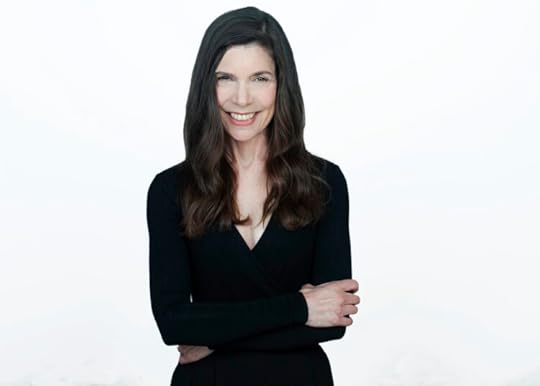 Welcome to Cantastic Authorpalooza, featuring posts by and about great Canadian children’s book creators! Today’s guest: Bev Katz Rosenbaum
. Take it away, Bev!
Welcome to Cantastic Authorpalooza, featuring posts by and about great Canadian children’s book creators! Today’s guest: Bev Katz Rosenbaum
. Take it away, Bev!
Like many authors, I have many author friends. I also have all too many friends who gave writing-to-publish a shot and gave up after a short while. Some of them went on to self-publish their books. I think self-publishing is a grand option if you’re happy to take on all the jobs besides writing it entails; many of my talented editing clients self-publish. But an equal number of talented friends and clients stopped writing altogether.
I know just as many authors who were traditionally published and who gave up after their first books were put out into the world with little fanfare and whose second books met with rejections. Others hung on for another one or two books, then gave up.
I’m an author who could have given up after one or two books but didn’t. And I’m so glad I didn’t. Because it’s only with my seventh book, my young adult novel I’m Good and Other Lies, about (in part) a teen struggling through the pandemic, that I feel everything has come together for me writing-wise. And I’m finally getting some critical attention. (I got my *first* Kirkus review with this book, and it described I’m Good and Other Lies as ‘pitch-perfect’ and ‘important’!)
I had a big birthday this year–one with a zero at the end of it. And if I’ve learned anything over my life to this point, it’s to do away with arbitrary timelines. Sure, some people make big splashes in their fields right out of the gate. But for many of us, it’s more of a slow burn. (Please excuse the mixed metaphors!) With every book, I learned a little more–learned how to write better, which topics and themes are more likely to sell, and also what to ask of my team (publisher, agent, etc.). Remember how, in Outliers, Malcolm Gladwell told us it takes ten-thousand hours of intensive practice to achieve mastery of complex skills? Turns out it’s true!
I published my first book, a romance novel I thank the universe has no digital footprint, just before I turned thirty. I expected from that point on, I’d be able to regularly publish. Haha. I didn’t sell another book for many years. Which is a pretty common phenomenon, I’ve learned.
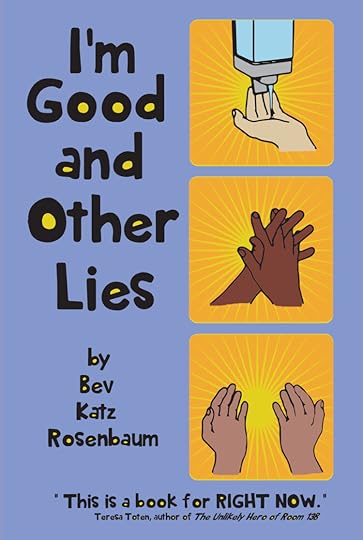 That first book has usually been gelling in your head for years and has something special that makes an editor sit up and notice. Some people are able to replicate that specialness with subsequent books. I was not. But when ‘chick lit’ became a big thing, I was enchanted and finally able to sell my second book in that genre. It didn’t make the splash I would have liked, but that marketplace became very crowded very quickly, and I knew my writing wasn’t quite there yet. (Side note: I now find the premise of that book, with a twenty-nine year old panicking about how her life isn’t what she imagined it by age thirty, hilarious.)
That first book has usually been gelling in your head for years and has something special that makes an editor sit up and notice. Some people are able to replicate that specialness with subsequent books. I was not. But when ‘chick lit’ became a big thing, I was enchanted and finally able to sell my second book in that genre. It didn’t make the splash I would have liked, but that marketplace became very crowded very quickly, and I knew my writing wasn’t quite there yet. (Side note: I now find the premise of that book, with a twenty-nine year old panicking about how her life isn’t what she imagined it by age thirty, hilarious.)
There was another long gap until I was published again, this time in a category I would stay in–young adult. I Was a Teenage Popsicle sold in a two-book deal to a big house. People loved the first book’s premise (a cryonically preserved, popular teen is thawed into a world she doesn’t get and is now the un-coolest) but I knew it still wasn’t the best I could do. And by the time its sequel came out, the YA marketplace, which had seen publishers madly scramble for the next Harry Potter, was suddenly as glutted as the chick lit one.
My next YA sold only in Germany! That’s probably a good thing. There was definitely an air of desperation to that one.
At that point, I decided to take a break from writing. A former in-house fiction editor, I was now busy building up a freelance editing business and raising my kids. I told myself I’d write again only when an idea really pulled at me. And one did, after the 2016 U.S. election. Who is Tanksy? is a satire of that election set at a middle school, which sold to Orca’s ‘Currents’ line for striving readers. I’m proud of that one, but after writing it, I realized YA was where I felt most comfortable.
Which brings me to I’m Good and Other Lies. It’s the YA book of my heart about a kid in a difficult family situation, suddenly stuck in it 24/7 during the pandemic. As for the writing itself, I babied every sentence and am so proud of each page! As I said, critics seem to agree it’s the best thing I’ve done.
It’s a long game, folks–you need to play it to the end! Not that it’s the end for me–stay tuned..!



